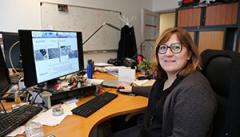
Research
Public health, environment and tribology
How can we reduce the emission of wear particles? By, for example, observing the transport sector from every angle, as tribologists do, anxious to provide answers to the problem of air quality in order to preserve people's health.
Pollution record in New Delhi on Sunday 3 November. With a concentration of fine particles more than thirty-two times higher than the WHO recommendations, the Indian capital has set a grim record. Between motor traffic, industrial emissions and smoke from agricultural burning in neighbouring regions, New Delhi is choking and the air polluted.
‘It's far from home but it should concern us’, says Sylvie Descartes, researcher at the Contact and Structure Mechanics Laboratory (LaMCoS) at INSA Lyon. ‘Greater Lyon regularly records high pollution levels and we must contribute through our research to avoid reaching such extremes’, she adds.
Taking many factors into account
But why is air quality of interest to this tribology scientist? ‘It is a decisive indicator of air pollution with fine or ultrafine particles. A significant part of this pollution is due to transport’, replies the researcher.
The contact of vehicle tyres driving on asphalt, the friction of the brake pads tightened on the disc during braking and the wear of road surfaces are all part of the equation. It's all about tribology and the flow of particles, particles that we also need to know how to collect, analyse and study. ‘Our job as tribologists is complex and unique in having to take many factors into account: mechanical, physico-chemical, material, thermal - interdependent and interacting factors, multi-scale variables. How and where can these particles be measured (size from nanometres to millimetres)? Indeed, once emitted out of contact, these particles will continue to evolve according to the environment (chemical interactions to form new components, photosensitivity, fragmentation, decomposition, agglomerates, etc.). And in these cases, how can we trace them back to their origin in contact? How can they be characterised when not all the standards are in place? How can we reduce their emissions? How can we control wear, in a nutshell?’, she asks.
‘Our job is to construct a story’
Although researchers have mastered the intellectual approach, it is the various possible scenarios that complicate the analysis. ‘A brake pad, for example, is made up of several components, all of which have a role. If, in order to reduce wear or to comply with a new standard, we decide, for example, to remove a component that plays a heat dissipating role in the operation of the brake, a solution must be found that performs the same role through awareness of the causes and consequences of this change, while maintaining the efficiency and safety of the device’, explains Sylvie Descartes.
This is a wide remit for tribologists working on the subject, who are grappling with concepts of mechanics, physics, chemistry and even climatology. ‘For example, when there is no wind, the particles remain concentrated in the same place. This can be very dangerous in the case of air pollution, as was the case in London, with the Smog of 1952. Our job is to understand the various elements, arrange them and construct a story’, sums up Sylvie, guided by the desire to deal with the problem at source.
To preserve people's health
Because when it comes to fine/ultrafine particles, it's all about human health. How can we measure the impact of these particles on the human body? How do we know whether fine particles are responsible for respiratory problems such as asthma, or worse? ‘Research is also being carried out at LaMCoS in this area, in partnership with hospitals in particular. The story never ends in tribology, and in this particular case of air pollution, tribologists must also try to find solutions to limit emissions’, she concludes.
In Lyon, over the past year, the biggest peak in fine particle pollution was recorded in February, with a daily average of 25.2 micrograms of fine particles PM*2.5 per cubic metre of air, when the World Health Organisation (WHO) recommends that this figure should not exceed 25 micrograms.
Other pollutants threaten air quality on an ongoing basis. One example is nitrogen dioxide (NO2), a pollutant gas from diesel engines. France, in the European Commission's sights on this subject, has just been criticised by the European Court of Justice for regularly exceeding the NO2 threshold limit. 24 French cities are affected, including Lyon

The 7th World Tribology Congress (WTC 2021) will take place in Lyon from 5 to 10 September, 2021. The congress venue is the Lyon convention centre, between the Rhône and the Parc de la Tête d'Or, in the heart of Cité Internationale. WTC 2021 is organised by two research laboratories in the region, the Contact and Structure Mechanics Laboratory (LaMCoS) at INSA Lyon and the Tribology and Systems Dynamics Laboratory (LTDS) at the ECL, with the support of the French Association of Mechanics (AFM) and the International Tribology Council (ITC).
For more information, please contact the project steering committee: Michel Belin, Philippe Kapsa, Philippe Vergne.
https://www.wtc2021.org/* Fine particles are particles with a diameter of less than 2.5 micrometres. They are referred to as PM 2.5.

